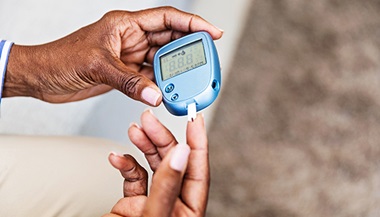Hypoglycemia (Low Blood Sugar)
The dangers of low blood glucose
At some time, most people with diabetes experience the sweating and shakiness that occurs when blood glucose levels fall below 70 mg/dl — a condition known as hypoglycemia. The average person with type 1 diabetes may experience symptoms of low blood glucose up to two times a week. However, not all are aware that these symptoms can rapidly progress to seizures, coma and even death if hypoglycemia is severe. Though hypoglycemia can be common and occur repeatedly in some people with diabetes, symptoms of low blood glucose should always be taken seriously. People with diabetes and their families, friends or coworkers should be prepared to act quickly and responsibly at the earliest signs of low blood glucose.
Early signs of hypoglycemia:
- Sweating
- Racing heartbeat
- Flushed face
- Anxiety
- Hunger pangs
Late signs of hypoglycemia:
- Headaches
- Dizziness
- Lightheadedness
- Confusion
- Difficulty speaking
- Seizures
- Coma
What causes low blood glucose?
- Symptoms occur when blood glucose levels fall below 70 mg/dl — a condition known as hypoglycemia.
- In most cases, low blood glucose results from overtreatment: Either taking too much diabetes medication or not eating enough food. Higher doses of medicine than the person actually requires can also lead to hypoglycemia.
- People who aim for too-low values on their A1C test (which measures blood glucose control over the previous three months) tend to experience more frequent drops in blood glucose.
- Vigorous exercise doesn't just burn calories, it also burns blood glucose! Hypoglycemia can occur unless blood glucose levels are carefully monitored during and after exercise.
- Not eating on a regular basis can deprive the body of glucose and make it difficult to prevent hypoglycemia. Eat balanced meals throughout the day and always keep a snack on hand.
No symptoms? Be alarmed
Surprisingly, the most dangerous episodes of hypoglycemia occur with little or no warning. When low blood glucose occurs on a regular basis, the body can become used to the warning signs and the person may stop noticing symptoms. This is a particularly dangerous condition known as hypoglycemic unawareness. People with this condition might not realize they have low blood glucose until it's dangerously low — seizures and coma are sometimes the first indication of a problem. The good news is that this condition can often be reversed — allowing people to once again notice the signs of low blood glucose — if hypoglycemia is avoided for a few weeks through careful monitoring of blood glucose.
How can I prevent low blood glucose?
All people with diabetes:
- If you experience low blood glucose often, ask your doctor if setting a higher goal for your A1C level may be appropriate.
- Ask your doctor to look at the test results from your home blood glucose monitor. These results reveal how often you have low blood glucose and when these episodes occur. Your doctor will look for patterns to see if low glucose happens after exercise or at certain times of day, for example.
- If you've had low blood glucose in the past, consider wearing a medical alert bracelet so that others will know that you have diabetes in the event of an emergency.
- Keep a fast-acting carbohydrate in your bag, desk drawer, car and other places for easy access. Good options include hard candy, fruit juice or glucose paste or tablets, which can be purchased at most pharmacies.
- Ask your doctor for an emergency glucagon kit. This kit contains a fast- acting medication that can be injected in case of loss of consciousness because of low blood glucose. Keep one kit at home and one at work or school.
- Monitor your blood glucose regularly so that low levels can be corrected before symptoms progress.
Make an emergency plan
Friends, relatives, coworkers and caregivers should be trained to recognize the signs of low blood glucose and know what to do — including how to inject glucagon in case of an emergency — as well as what not to do.





